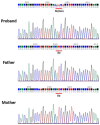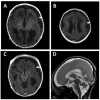Tubulinopathy Presenting as Developmental and Epileptic Encephalopathy
- PMID: 35892608
- PMCID: PMC9332459
- DOI: 10.3390/children9081105
Tubulinopathy Presenting as Developmental and Epileptic Encephalopathy
Abstract
Tubulin proteins play a role in the cortical development. Mutations in the tubulin genes affect patients with brain malformations. The present report describes two cases of developmental and epileptic encephalopathy (DEE) due to tubulinopathy. Case 1, a 23-year-old boy, was found to have a brain malformation with moderate ventriculomegaly prenatally. Hypotonia was noted at birth. Seizures were noted on the 1st day with multifocal discharges on the EEGs, which became intractable to many anticonvulsants. Brain MRI showed marked dilated ventricles and pachy/polymicrogyri. He became a victim of DEE. A de novo mutation in TUBB2B was proven through next-generation sequencing (NGS). Case 2, a mature male baby, began to have myoclonic jerks of his limbs 4 h after birth. EEG showed focal sharp waves from central and temporal regions. Brain MRI showed lissencephaly, type I. The seizures were refractory initially. A de novo mutation in TUBA1A was proven at the 6th week through NGS. He showed the picture of DEE at 1 year and 2 months of age. The clinical features of the tubulinopathies include motor delay, intellectual disabilities, epilepsy, and other deficits. Our cases demonstrated the severe form of tubulinopathy due to major tubulin gene mutations. NGS makes the early identification of genetic etiology possible for clinical evaluation.
Keywords: TUBA1A; TUBB2B; developmental and epileptic encephalopathy; pediatric; tubulinopathy.
Conflict of interest statement
The authors declare no conflict of interest.
Figures






References
-
- Scheffer I.E., Berkovic S., Capovilla G., Connolly M.B., French J., Guilhoto L., Hirsch E., Jain S., Mathern G.W., Moshé S.L., et al. ILAE classification of the epilepsies: Position Paper of the ILAE Commission for Classification and Terminology. Epilepsia. 2017;58:512–521. doi: 10.1111/epi.13709. - DOI - PMC - PubMed
Publication types
LinkOut - more resources
Full Text Sources

